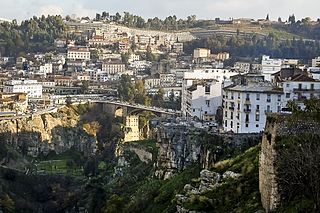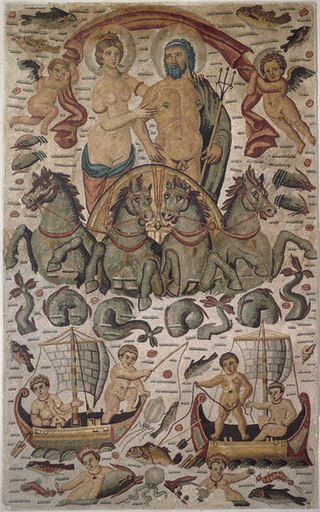Related Research Articles

Algeria, officially the People's Democratic Republic of Algeria, is a country in North Africa. Algeria is bordered to the northeast by Tunisia; to the east by Libya; to the southeast by Niger; to the southwest by Mali, Mauritania, and Western Sahara; to the west by Morocco; and to the north by the Mediterranean Sea. It is considered part of the Maghreb region of North Africa. It has a semi-arid geography, with most of the population living in the fertile north and the Sahara dominating the geography of the south. Algeria covers an area of 2,381,741 square kilometres (919,595 sq mi), making it the world's tenth largest nation by area, and the largest nation in Africa, more than 200 times as large as the continent’s smallest country, The Gambia. With a population of 44 million, Algeria is the tenth-most populous country in Africa, and the 32nd-most populous country in the world. The capital and largest city is Algiers, located in the far north on the Mediterranean coast.

Much of the history of Algeria has taken place on the fertile coastal plain of North Africa, which is often called the Maghreb. North Africa served as a transit region for people moving towards Europe or the Middle East, thus, the region's inhabitants have been influenced by populations from other areas, including the Carthaginians, Romans, and Vandals. The region was conquered by the Muslims in the early 8th century AD, but broke off from the Umayyad Caliphate after the Berber Revolt of 740. During the Ottoman period, Algeria became an important state in the Mediterranean sea which led to many naval conflicts. The last significant events in the country's recent history have been the Algerian War and Algerian Civil War.

As the tenth-largest country in the world, and the largest in Africa and in the Mediterranean region, Algeria has a vast transportation system that includes a large and diverse transportation infrastructure.

Constantine, also spelled Qacentina or Kasantina, is the capital of Constantine Province in northeastern Algeria. During Roman times it was called Cirta and was renamed "Constantina" in honour of Emperor Constantine the Great. It was the capital of the French department of Constantine until 1962. Located somewhat inland, Constantine is about 80 kilometres from the Mediterranean coast, on the banks of the Rhumel River.

Cirta, also known by various other names in antiquity, was the ancient Berber and Roman settlement which later became Constantine, Algeria.

The University of Algiers, commonly called the Algiers 1 University, is a public research university located in Algiers, Algeria. It is the oldest and most prestigious university in Algeria. Emerging from a series of independent institutions in the 19th century, it was organized as a university in 1909 and profoundly reorganized in 2009.
Boumedfaa a town in northern Algeria.

El Amra is a town in northern Algeria.

Khemis Miliana is a town in northern Algeria of around 500000 inhabitants. It is a university town located 120 kilometers west of Algiers. It was known as Malliana in Roman times, then Affreville during the French colonial era. It should not be confused with the smaller city of Miliana nearby.

Algeria is the largest country in Africa; one of the main tourist attractions is the Sahara, the largest desert in the world. Algeria has been a member of the World Tourism Organization since 1976. According to a report of the World Tourism Organization published in 2014, Algeria was the 4th largest tourist destination in Africa in 2013 with 2.7 million foreign tourists, and ranks 111th on the international tourism scene, according to the London-based World Tourism and Travel Council (WTTC). The tourism sector in Algeria accounts for 3.9% of the volume of exports, 9.5% of the productive investment rate and 8.1% of the gross domestic product.

The French conquest of Algeria took place between 1830 and 1903. In 1827, an argument between Hussein Dey, the ruler of the Deylik of Algiers, and the French consul escalated into a blockade, following which the July Monarchy of France invaded and quickly seized Algiers in 1830, and seized other coastal communities. Amid internal political strife in France, decisions were repeatedly taken to retain control of the territory, and additional military forces were brought in over the following years to quell resistance in the interior of the country.

Tadjenanet, formerly called Saint-Donat, is a town and commune in Mila Province, Algeria.

Constantine was a French département in Algeria which existed between 1848 and 1974. The area of the former department, centered on the city of Constantine, is also referred to as Constantinois.

Ramdane Djamel is a town and commune in Skikda Province in north-eastern Algeria.
Sidi Ghiles Formerly Novi during the French colonization, is a town on Algeria's Mediterranean coast. The municipality of Novi is located about 32 kilometers (20 mi) west of Tipasa and 7 kilometers (4 mi) southwest of Cherchell. This agricultural locality is a hundred kilometers (62 mi) distant of Algiers.

Djelloul Khatib alias commandant Djelloul was a combatant for the Algerian independence and a public servant. During the war of independence he led the efforts towards the professionalization of the National Liberation Army (NLA). He contributed thereafter to building the civil service of newly independent Algeria.

The Battle of Chelif or Battle of Djidouia took place on 28 April 1701 on the banks of the Chelif River. It was fought between the armies of the Alaouite Sultan Ismail Ibn Sharif and those of the Regency of Algiers commanded by the Bey of Mascara, Mustapha Bouchelaghem. It took place in the context of an attempt by the Alaouites to conquer the west of the Regency of Algiers, coordinated with an offensive by Tunis on the east of the Regency of Algiers in 1700 and 1701.
Hocine Mezali is an Algerian journalist and writer. He had been the head of intelligence during the Battle of Algiers (1956–1957).
The Constantine campaign was launched by Bey of Tunis Murad III Bey in 1699 to capture the Beylik of Constantine, situated in the east of the Deylik of Algiers.
References
- ↑ November 2, 1957 The Bridgeport Telegram from Bridgeport, Connecticut· Page 16. via Newspapers.com (subscription required)
- ↑ "£2,000,000 Daily to Keep Algiers". The Canberra Times 19 November 1957.
- ↑ Bernard Top (1 January 2005). La campagne du 6e régiment de Cuirassiers en Algérie 1955-1963: Honneur et tradition. Thélès Editions. ISBN 978-2-84776-412-3.
- ↑ W. H. C. Frend (2003). From Dogma to History: How Our Understanding of the Early Church Developed. SCM Press. ISBN 978-0-334-02908-3.
- ↑ Bulletin archéologique du Comité des travaux historiques et scientifiques: Afrique du nord. Bibliothèque nationale. 1984.
- ↑ The Bulletin of the American College of Physicians. American College of Physicians. 1964. pp. 226-.